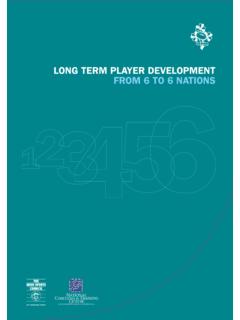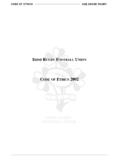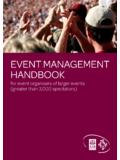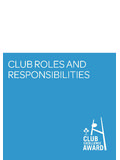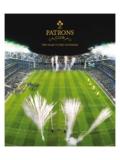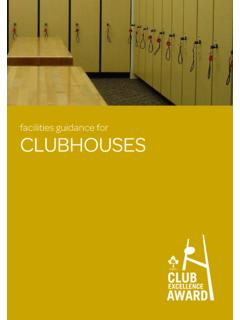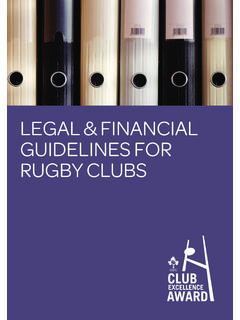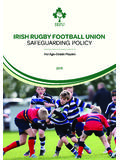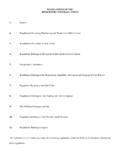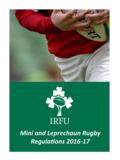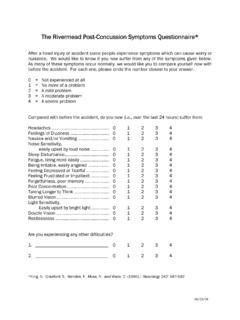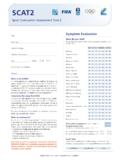Transcription of A GUIDE TO IN RUGBY UNION - irishrugby.ie
1 The aim of this brochure is to provide information on concussion to those involved in RUGBY UNION in Ireland. concussion MUST be taken extremely seriously. Any player with a suspected concussion MUST be removed immediately from training/play and not return. They should be medically assessed. They MUST not be left alone and MUST not drive a GUIDE TO IN RUGBY UNIONWhy MUST concussion be taken extremely seriously? Ignoring the signs and symptoms of concussion may result in death, a more serious brain injury or a prolonged recovery period. The potential for serious and prolonged injury emphasises the need for comprehensive medical assessment and follow-up until the concussion has fully resolved. Returning to play before complete resolution of the concussion exposes the player to recurrent concussions that might take place with ever decreasing forces.
2 Repeat concussions could shorten a player s career and may have some potential to result in permanent neurological (brain) impairment. There is no such thing as a minor concussion or knock to the head . What is concussion ? concussion is a traumatic brain injury. It is a complex process in which forces are transmitted to the brain and result in temporary impairment of brain function. concussion can have a significant impact on the short and long term health of player if not managed causes concussion ? concussion can be caused by a direct blow to the head or body and from whiplash type movements of the head and neck that can occur when a player is tackled or collides with another player or the ground.
3 Immediately following a suspected concussion , the brain is susceptible to further significant damage in the event of another impact. Therefore the player MUST be immediately removed from activity and MUST NOT return until they have completed the graduated return to play (GRTP) are the visible clues of a suspected concussion ?Players, coaches, healthcare professionals and referees should be familiar with the visible clues of a suspected concussion . If a player has ANY ONE of the visible clues they MUST be immediately removed from activity and MUST NOT return until they have completed the graduated return to play (GRTP) GUIDE TO IN RUGBY UNION Lying motionless on ground Slow to get up Unsteady on feet Balance problems or falling over Grabbing/Clutching head Dazed, blank or vacant look Confused/Not aware of plays or events Suspected or confirmed loss of consciousness Loss of responsivenessRECOGNISE AND REMOVEWhat are the signs and symptoms of a concussion ?
4 The signs and symptoms of concussion usually start at the time of the injury but the onset of these may be delayed for up to 24 48 hours. Parents/guardians, family members and friends should be aware of the signs and symptoms of a concussed player. If a player has ANY ONE of the signs and symptoms they MUST be immediately removed from activity and MUST NOT return until they have completed the graduated return to play (GRTP) happens if a player has a suspected concussion at training or when playing? The player MUST be immediately removed from activity and MUST NOT return. The player MUST NOT be left alone. The player MUST NOT drive a vehicle. The player MUST always be in the care of a responsible adult, who is informed of the player s suspected concussion .
5 The player should be medically assessed as soon as suspected concussion MUST be taken extremely seriously. The Pocket concussion Recognition Tool (PCRT) can be used to assist in the recognition of a suspected GUIDE TO IN RUGBY UNION Loss of consciousness Seizure or convulsion Balance problems Nausea (feeling sick) or vomiting Drowsiness Player is more emotional Irritability Sadness Fatigue or low energy Player is more nervous or anxious Confusion Don t feel right Headache Dizziness Feeling slowed down Pressure in head Blurred vision Sensitivity to light Amnesia Feeling like in a fog RECOGNISE AND REMOVEA GUIDE TO IN RUGBY UNIONF ellow players/coaches/parents: YOUR responsibility.
6 You MUST do your best to ensure that the player is removed from play in a safe manner, if you observe them displaying any of the visible clues or signs or symptoms of a suspected concussion . You MUST NOT allow a player to play RUGBY until they have completed the graduated return to play (GRTP) protocol if they are displaying signs or symptoms of a suspected concussion sustained while playing RUGBY or another sport. You MUST ensure that the player is in the care of a responsible adult and inform them of the player s suspected : YOUR responsibility: If you have symptoms of a suspected concussion you must STOP playing and INFORM medical and/or coaching staff immediately. Be honest with yourself and those looking after you.
7 If you have symptoms of a suspected concussion sustained while playing RUGBY or another sport, you MUST NOT play RUGBY until you have completed the graduated return to play (GRTP) suspected concussion or a concussion , how does the player return to play?The player should avoid activities that require concentration or attention until symptoms have been absent for a minimum of 24 hours. Symptoms may be masked by medications such as headache tablets, anti-depressants and/or sleeping medication and caffeine. The graduated return to play (GRTP) of a player following a concussion should be undertaken on an individual basis with the full cooperation of the player. * under age (U6 s - U20 s) players playing adult RUGBY must follow age group guidelinesPlayers may not return to play until:1.
8 All their symptoms have subsided. 2. they have followed the GRTP protocol. 3. they have been medically cleared to and schools should have the contact details and directions for a local doctor or emergency services listed on their noticeboard and provided to all coaches and AND REMOVEIRFU concussion GUIDELINESAGE GROUP MINIMUM REST PERIOD POST concussion GRTP MINIMUM TIME OUTU6 s - U20 s* 14 Days 8 Days 23 Days (3 Weekends Missed)ADULT 14 Days 6 Days 21 Days (2 Weekends Missed)A GUIDE TO IN RUGBY UNION ISSUE RESPONSE INJURY Player assessed on pitch (visible clues and signs/symptoms) SUSPECTED concussion Player MUST be immediately removed from activity and MUST NOT return RECOGNISE AND REMOVE MANAGEMENT Player referred to doctor or Emergency Department for diagnosis and further assessment RETURN TO PLAY Player rests as per concussion guidelines on previous page and undertakes graduated return to play (GRTP) protocol as per below table Other players, parents, coaches and administrators should insist that the above guidelines are always followed and be vigilant for the return of symptoms, even if the GRTP protocol has been successfully completed.
9 Please note that each stage in the GRTP protocol may take longer than the minimum period stated below. Players with concussion should not move to the next stage in the event that any symptoms are still return to play (GRTP) protocolPlayers can only move on to the next stage once they have been symptom free during the full period of each stage. If they are not symptom free, they must stay at that stage until they stage Exercise at each stage Objective of stage Adult U6 s - U20 s of rehabilitation RestNoneRest1. No activityRecoveryIncrease heart rateAdd movementExercise, coordination and mental load2. Light aerobic exercise3. RUGBY -specific exercise4. Non-contact training drills6. After 24 hours, return to play5.
10 Following medical clearance, full contact practiceComplete physical and mental rest without symptomsWalking, swimming or stationary cycling keeping intensity <70% maximum predicted heart rate (Max predicted heart rate = 220 Player Age). No resistance trainingRunning drills. No impact activitiesProgression to more complex training drills passing drills. May start progressive resistance trainingMay participate in normal training activitiesPlayer rehabilitatedRecoveredRestore confidence and assess functional skills by coaching staff14 days2 days2 days2 days23 days2 days1 day14 days1 day1 day1 day21 days2 daysRECOGNISE AND REMOVEA GUIDE TO IN RUGBY UNIONU seful Contact DetailsEmergency Services: 999 or 112 Club/School: Doctor Name:Tel: 2013 concussion in Sport Group 2013 concussion in Sport GroupPocket concussion RECOGNITION TOOL To help identify concussion in children, youth and adults3.
